Title 42 updates from the US-Mexico border: Thousands estimated to be waiting to cross border
What's next along the border? More than 2.7 million people have been turned away in the three years the Title 42 restrictions have been in effect.
At 8:59 p.m. Thursday, the pandemic-era restrictions lifted. However, a federal judge in Florida blocked the Department of Homeland Security from releasing migrants under parole into the interior of the United States. The judge’s order when into effect at the same time that Title 42 ended.
Reporters from The Arizona Republic and the USA TODAY Network are covering the news across the U.S. Southwest and Mexico. Return here for frequent updates.
Some migrants arrive without appointments
NOGALES, Sonora — One Ecuadorian family and two Mexican nationals arrived at the Dennis DeConcini Port of Entry to request asylum without a CBP One appointment on Friday.
The Ecuadorian family arrived at 11 a.m. and wasn't processed until at least four and a half hours later, according to Chelsea Sachau, managing attorney of the Border Action Team at the Florence Immigrant and Refugee Rights Project.
Sachau was present at the port to wait with and assist the family through the process.
The family and the two nationals were taken into the port to be processed by 5:30 p.m.
— José Ignacio Castañeda
Migrants wait for appointments across from Yuma County
SAN LUIS COLORADO — Across the border from San Luis, Arizona, in Yuma County, migrants running from horrific violence have been waiting for months to get appointments with U.S. Customs and Border Protection to argue their cases for asylum in the U.S.
Since the lifting of Title 42 on Thursday night, at least two of them have appointments after almost five months of waiting in limbo.
While staying at the migrant shelter Divina Providencia, Soraya Amaya and Evelin Castillo have both been able to book appointments on the CBP One mobile application.
Since the application’s release on Oct. 28, 2020, the few open spots for applicants compared with the high number of people applying has meant spots book up fast. Others have complained about bugs and error messages.
CBP One app: The app worked for this family. Others raise concerns
Castillo decided to make the trek to the U.S. after people threatened to kill her and everyone else in the store she worked at unless they were paid a ransom.
Castillo, her daughter and her cousin traveled for 15 days, hitching rides in the back of trucks, she said. Once in Mexico, she tried to cross the border to turn herself in, but she was detained and sent back to Mexico under Title 42.
She found the shelter in San Luis and has been at Divina Providencia since December. Months of trying to get an appointment with no luck had made her feel hopeless.
“I said I guess I’ll have to settle here,” she said. “I would cry thinking about how I didn’t want to return (to Guatemala).”
However, almost two weeks ago, Castillo successfully booked an appointment on May 2 for mid-May.
For Amaya, Thursday was the day she successfully got an appointment.
Amaya left El Salvador when her family began to receive death threats after being forced to pay a fee to keep their shop open. In Mexico, she and her child were almost kidnapped by cartels while in Chiapas, Mexico.
Now with appointments, they have hope they can finally live in safety in the U.S.
— Sarah Lapidus
US officials ask Phoenix shelters to expand capacity for incoming migrants
Government and congressional authorities have asked some Phoenix-area migrant shelters to increase their capacity after the expiration of Title 42, according to pastors of local centers, but the lack of resources, volunteers and infrastructure prevented them from complying with such requests.
Ángel Campos, pastor at Monte Vista Church of Christ in Phoenix, said he made an exception Friday to receive more immigrants being dropped off by border officials. The church has served as temporary shelter since 2018, coordinating with federal authorities to receive and help undocumented immigrants who are released after crossing the border.
“Authorities have just called us telling us that they want us to increase our capacity,” Campos told The Republic. “As of right now, we have the capacity to receive about 100 migrants. Today we received 40.”
He said that his church does not typically receive undocumented folks on Fridays.
Campos said that the last thing they want is to overload the facilities and, moving forward, volunteers will try to help those who are arriving as quickly as possible, connecting them with their relatives and clearing up space for others to arrive.
Unlike 2018, when Campos would personally pick up immigrants from the Welcome Center in Phoenix, now border officials drop off immigrants to Phoenix-area shelters.
Magdalena Schwartz, pastor at Vineyard Community Church in Gilbert, also received a call asking her to receive more immigrants than they usually accept.
"I told them that we could not expand our capacity because since we did not receive funds, we would continue receiving the same numbers that we have received up to now, maybe 40 or 50 more, but not too many," she said.
Vineyard has capacity for 150 people. On Thursday 42 arrived and on Friday they received another 48 people. Schwartz explained that the reception of immigrants only takes place on Thursdays and Fridays.
Pastor Héctor Ramírez, of the church Iglesia Cristiana El Buen Pastor in Mesa, said he received a call from Arizona officials asking him if he could pick up immigrants, saying they had several "buses" full of people in Yuma and they had nowhere to take them.
“For security reasons, we only take in 90 people,” said Ramírez, “We only have four showers, few bathrooms, and when people fill the place, problems begin, because we don't have enough resources or volunteers to attend to all of them.”
On Thursday they received 32 immigrants of which only seven remained by Friday afternoon. According to Ramírez, they expect to receive a larger group of immigrants next week now that Title 42 restrictions have been lifted.
— Javier Arce
Time will reveal impact on migrant aid organizations, shelters
NOGALES — With thousands of migrants waiting at the border to claim asylum and cross into the U.S., local aid organizations were still waiting to get a better idea of what’s ahead.
By late Friday morning, the Arizona side of the Nogales border entry had calmed from the morning rush of commuters with no obvious signs of asylum seekers in the mix.
“As of right now we haven’t seen any major changes,” said Diego Piña-Lopez, program manager for Casa Alitas Welcome Center in Tucson, the morning after the restrictions were lifted.
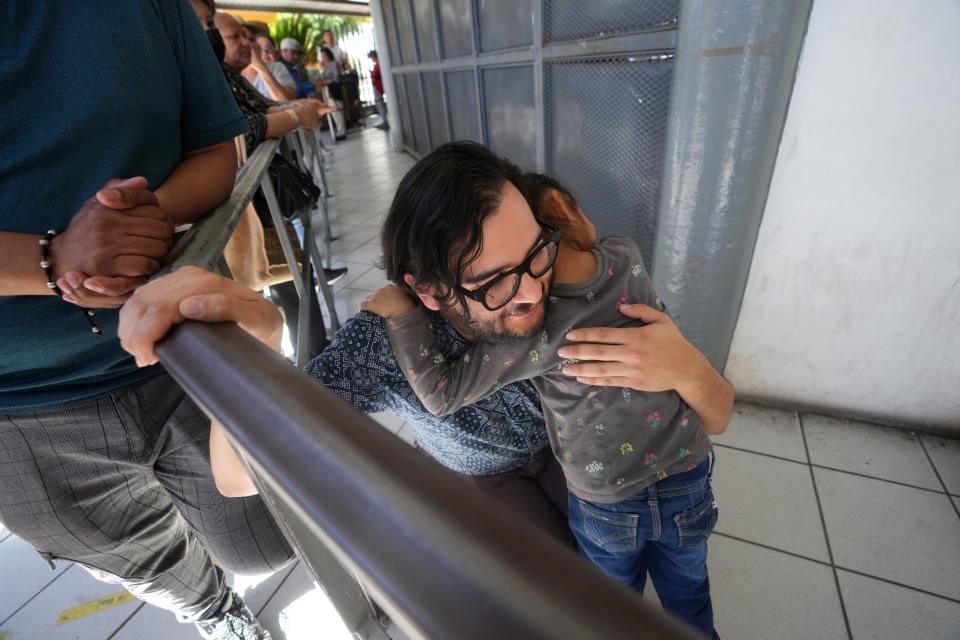
The main task for shelters and aid organizations will be adapting to the specific needs of the migrant population they are anticipating.
Many people have been waiting to claim asylum for months or years, and have very few clothes or possessions, he said.
Further, a large portion of migrants coming from Central America bring with them heart-wrenching stories of their journey including what Piña-Lopez calls their “Sophie’s choice:'' to stay in their current situations or to bring their children on the weeks-long trek through the Darién Gap, one of the most dangerous migration routes in the world.
“We as shelters are going to learn more of what the needs are for those folks and might have to increase a variety of our services to support those folks,” he said.
— Lacey Latch
Venezuelan migrants await asylum appointments
NOGALES, Sonora — Wilmer Rafael Carson Castillo left his home in Venezuela eight months ago.He sat on a metal bench steps away from the Dennis DeConcini Port of Entry in Nogales, Sonora, on Friday, waiting for a scheduled CBP One appointment with three other Venezuelan migrants who all attended the town hall meeting at the Kino Border Initiative migrant shelter the day prior.They sat on the bench more than three hours before their scheduled CBP One appointment at noon.“I feel happy and content because I’m going to be with my family,” Castillo said. “The experience is very difficult but you have to fight it. You have to fight for the wellbeing of the family.”Castillo crossed the border without authorization in Ciudad Juárez, Mexico, after being in the city for roughly three months. Castillo, his wife and his two children, 7 and 9, were detained by Border Patrol before Castillo was separated from his family and expelled in Tijuana, he said.
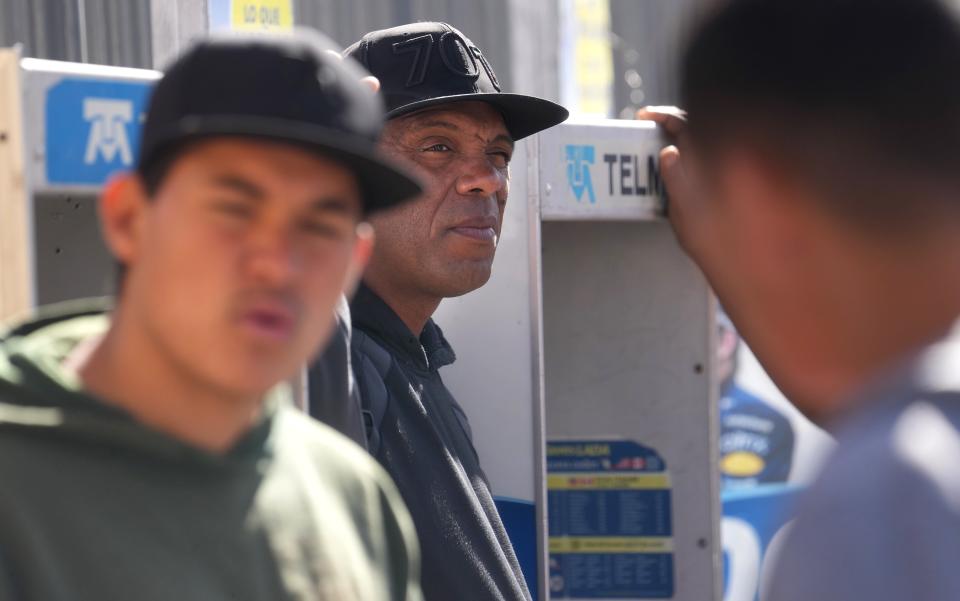
His wife and children were paroled into the country.Castillo stayed in Tijuana for about 20 days before he was able to book a CBP One appointment in Nogales for Friday. Castillo and his friend were both traveling in a large group after they crossed the Darién Gap, one of the world’s most dangerous immigration routes that connects Panama and Colombia.It took Castillo nine days to cross the Darién. Migrants must traverse the treacherous path of jungle and mountains, facing robbers, hunger, deadly animals and illness.“If you get sick there, you stay, because how do you get out of there,” Castillo said.“Suddenly you get out of the jungle, well, the other jungle is Mexico.”Some Venezuelan migrants have said that they prefer the deadly Darién Gap to traveling through Mexico, where they are often robbed, assaulted or in danger of being kidnapped. Castillo and his fellow traveler were now the only ones from the group who had not made it into the U.S. yet, he said.Within the port of entry nearby, two families sat on the ground in the pedestrian lane for the Secure Electronic Network for Travelers Rapid Inspection, an expedited program that allows preapproved, low-risk travelers to cross into the U.S. more quickly.A young boy from a family from southern Mexico sat next to his mom as he played with a yellow toy car on the ground. The family, with four small children, were indigenous language speakers and their CBP One appointment may take longer than others, given that border officials must get a translator to help.
The family may be released as late as 6 p.m. Friday, according to Chelsea Sachau, managing attorney of the Border Action Team at the Florence Immigrant and Refugee Rights Project. Sachau was present at the port of entry Friday to help asylum seekers as they wait for their appointments.Castillo urged fellow migrants to be patient and apply for an appointment through the CBP One app.“We’re happy because we got the appointment and I hope that God gives us the pass over there,” Castillo said.
— José Ignacio Castañeda
Legislators call upon Hobbs to ‘activate all available’ resources
Republican members of the Arizona Legislature called upon Gov. Katie Hobbs to “activate all available state resources” to address the end of Title 42.
The lawmakers sent the governor their letter Thursday.
“The State of Emergency in Arizona’s border counties that former Governor Ducey declared on April 20, 2021, is still in effect and continues as long as these conditions exist,” they wrote, adding that there should be $240 million in the Border Security Fund. The Legislature created the fund to prevent illegal entry into the state.
“We call upon you to take immediate action and activate all available state resources to keep our communities safe from these dangerous and unprecedented threats,” said the letter from Reps. Gail Griffin (Hereford), Lupe Diaz (Benson), Tim Dunn (Yuma), Michael Carbone (Buckeye), and Michele Pena (Yuma).
— Ryan Randazzo
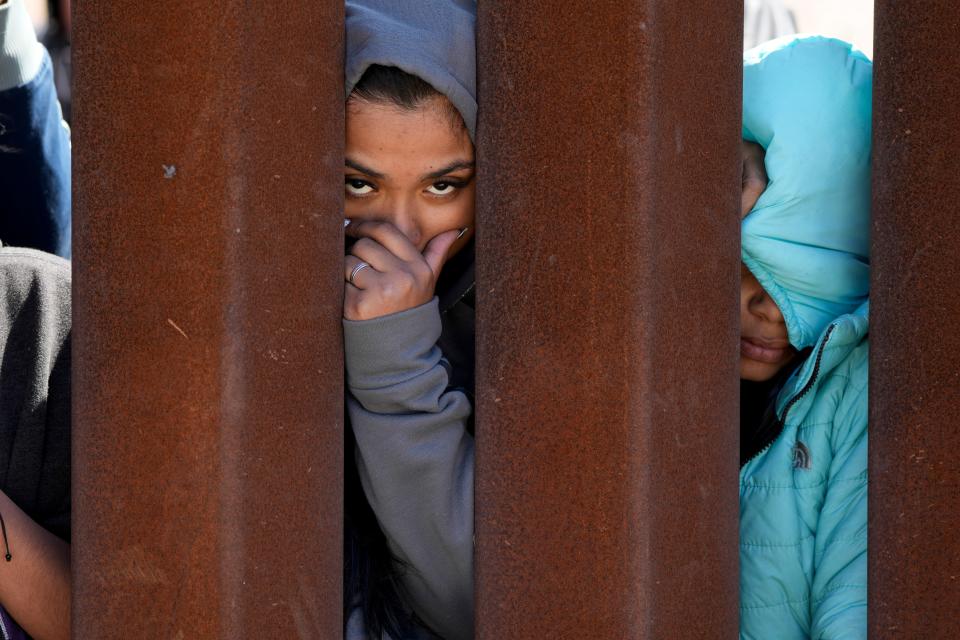
Thousands of migrants estimated to be waiting to cross border
NOGALES, Sonora — The line to cross into the U.S. through the Dennis DeConcini Port of Entry stretched out of the entry turnstiles and into the nearby sidewalk Friday morning.
The number of people in line was typical for this time of day and even shorter than other days and times, according to Francisco Olachea Martin, an advocate who provides humanitarian assistance to migrants regularly near the port of entry.
Here are some figures on migrants:
There are 360 migrants present on the Mexican side of the border in Nogales, Sonora, according to estimates released by the Mexican government.
There are 26,560 migrants on the Mexican side of the U.S.-Mexico border, per the government’s estimates.
There’s 10,000 migrants in Ciudad Juarez, 7,000 in Reynosa and 3,000 in Tijuana.
Nine hundred forty-two migrants were sent back to Mexico on Thursday with the majority of them coming from Venezuela.
— José Ignacio Castañeda
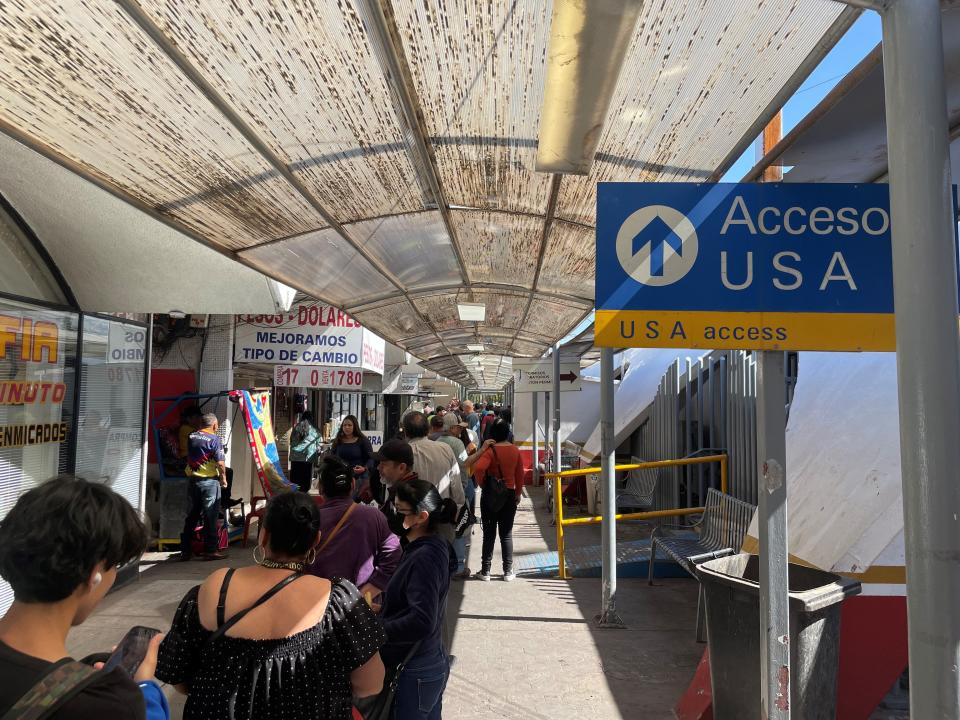
Greater number of asylum seekers expected to arrive in Phoenix on Friday
A total of 180 asylum seekers arrived on Thursday at The Welcome Center, a 340-bed shelter located in a remodeled school in Phoenix.
Another 220 asylum seekers are expected to arrive Friday, said Stanford Prescott, senior communications officer for the International Rescue Committee, which runs the center.
The number of asylum seekers arriving Thursday and Friday is above the approximately 110 arrivals the center had been receiving before Title 42 ended Thursday night but is well within the center’s capacity to serve, Prescott said.
Some of the asylum seekers were dropped off at the center directly by U.S. Department of Homeland Security authorities. Others arrived from shelters in Tucson and Yuma, Prescott said.
— Daniel Gonzalez
Guatemalan president’s calls stir controversy
Guatemalan President Alejandro Giammattei has been making calls to over half a dozen lawmakers, giving Republicans new fodder for bashing Biden over his immigration policies.
At issue is whether Guatemala could take in migrants with their sights set on the U.S.-Mexico border. That is one of the key initiatives the Department of Homeland Security is rolling out as the pandemic-era immigration policy ends.
As late as Thursday, the country’s Ministry of Foreign Affairs had still not confirmed publicly whether they would be collaborating with the Biden administration's plan, Guatemalan paper Prensa Libre reported.
Lawmakers, including Rep. Tony Gonzales, R-Texas, said Guatamalan officials were frustrated they could not reach officials in the Biden administration.
— Staff reports
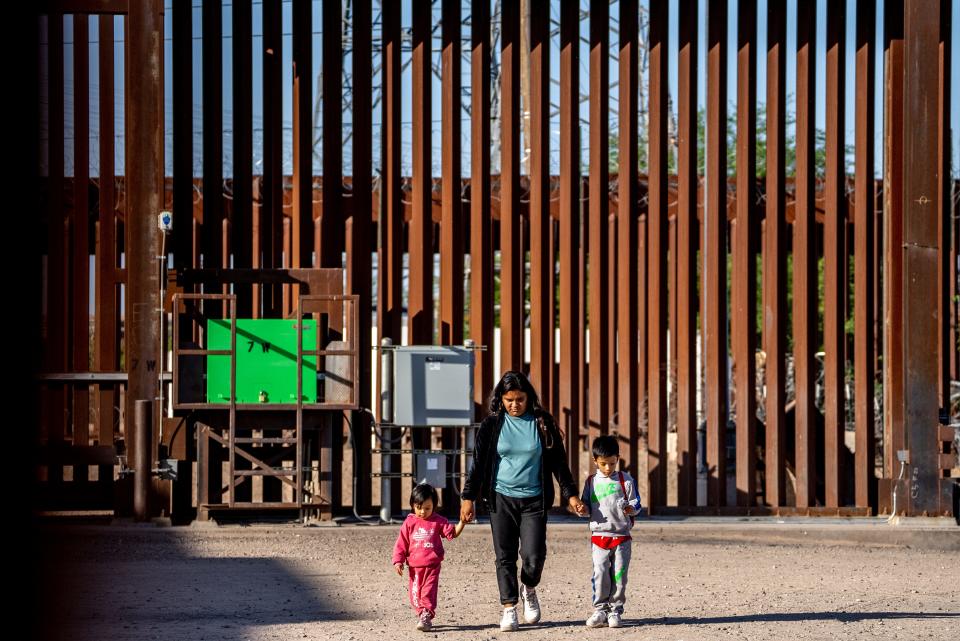
No surge in Nogales as of Friday morning
NOGALES — The morning after Title 42 officially expired, virtually nothing had changed on the U.S. side of the Dennis DeConcini port of entry in Nogales.
Hundreds of pedestrians trickled through into Arizona in a slow stream, as so many of them do every day.
There were no clear signs of significant delays as groups of schoolchildren in their uniforms giggled while racing up the ramp after gaining entry, passing by teenagers and workers who were preoccupied with their own conversations and daily routines.
Because traffic was limited to one lane on each side, it was slow-moving but consistent.
Numerous shuttle operators were waiting at the top of the ramp presumably in anticipation of a potential surge but soon realized there wasn’t going to be a sudden rush of new customers.
— Lacey Latch
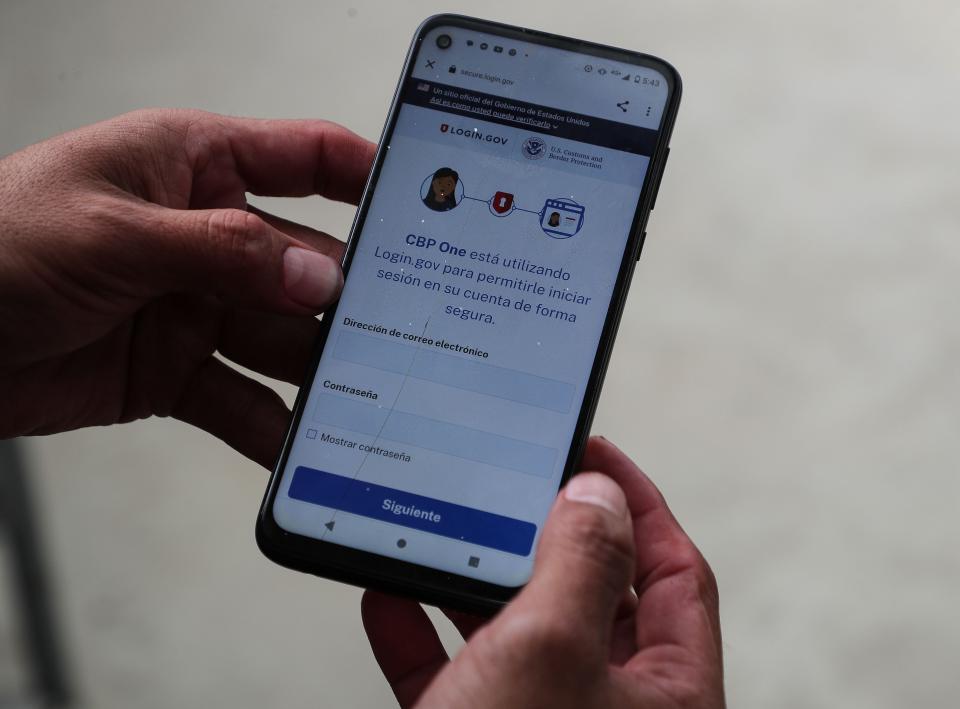
Ciscomani helps introduce law to extend Title 42
Rep. Juan Ciscomani, R-Ariz., and Rep. Jared Golden, D-Maine, introduced legislation Thursday to extend Title 42 for two years, which would allow officials to expel migrants at the border.
It would exempt people from removal if they face “persecution or torture because of their membership in a social, political, or religious group, or on a case-by-case basis for humanitarian or medical reasons,” according to an announcement from lawmakers.
The bill mirrors legislation in the Senate from Sen. Kyrsten Sinema, I-Ariz., and Thom Tillis, R-N.C.
“The expiration of Title 42 has brought greater chaos and uncertainty to our southern border,” Ciscomani said in a prepared statement. “Border communities in my district and other states cannot shoulder the burden of this crisis any longer.”
— Ryan Randazzo
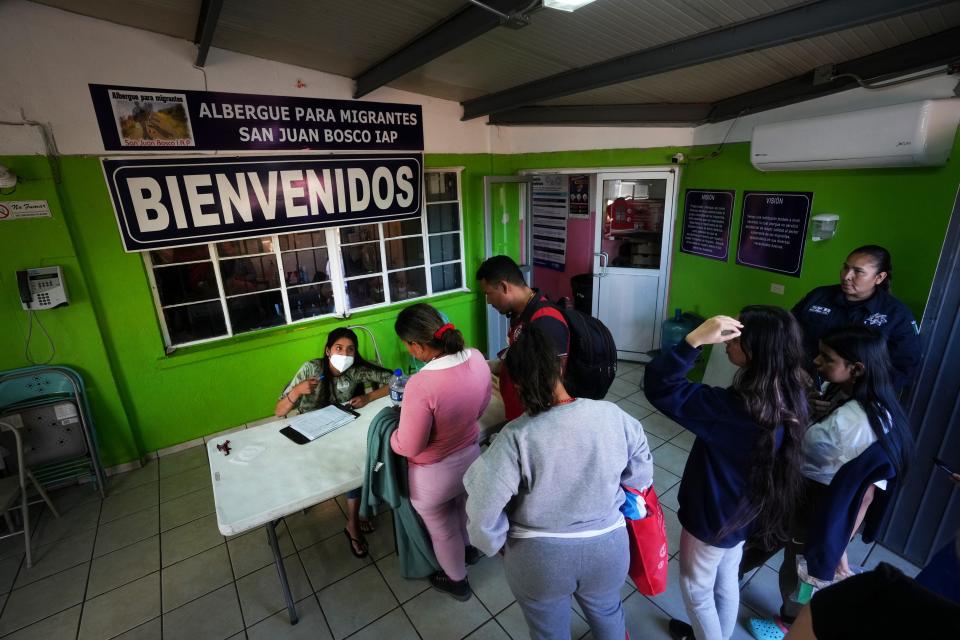
First asylum seekers arrive Friday in San Ysidro
TIJUANA — The first group of asylum seekers to be processed at the San Ysidro port of entry in San Diego under post-Title 42 changes lined up early Friday morning at the Chaparral border crossing in Tijuana.
These asylum seekers had secured appointments previously using the CBP One phone app. A large portion of the group included asylum seekers from other parts of the world such as Russia.
Prior to the end of Title 42, Customs and Border Protection had been making 200 appointment slots available each day to migrants waiting in Tijuana to be processed for asylum. But starting on Friday, the number of daily appointments increased to 240, according to Enrique Lucero, the director for Tijuana’s Migrant Affairs Office.
Lucero estimates that there were more than 14,000 migrants presently waiting in Tijuana’s shelters and hotels to claim asylum in the United States.
Starting on Friday, all asylum seekers waiting in Mexican border cities were required to make an appointment using the CBP One app in order to be considered for asylum in the United States.
Any other migrant that attempts to cross the border without authorization will be presumed ineligible for asylum under a final rule that took effect on Friday. The rule also makes migrants ineligible if they did not seek protection at a country they traveled through on their way to the United States.
— Rafael Carranza
No asylum seekers yet in Nogales without appointment
NOGALES, Sonora —The line of people waiting to cross into the U.S. was tailing out of the entrance gates at the Dennis DeConcini Port of Entry early Friday morning. Friday is the first full day that Title 42 is no longer in place.
The line stretched down the sidewalk nearby. A number of students are in line to cross into the U.S. and go to school.
A handful of people with folded manila envelopes stood in a pedestrian lane. The people were potentially waiting for their scheduled CBP One appointment at 7 a.m.
There was no sign of asylum seekers attempting to show up at the port without a CBP One appointment.
— José Ignacio Castañeda
All quiet as Title 42 lifts
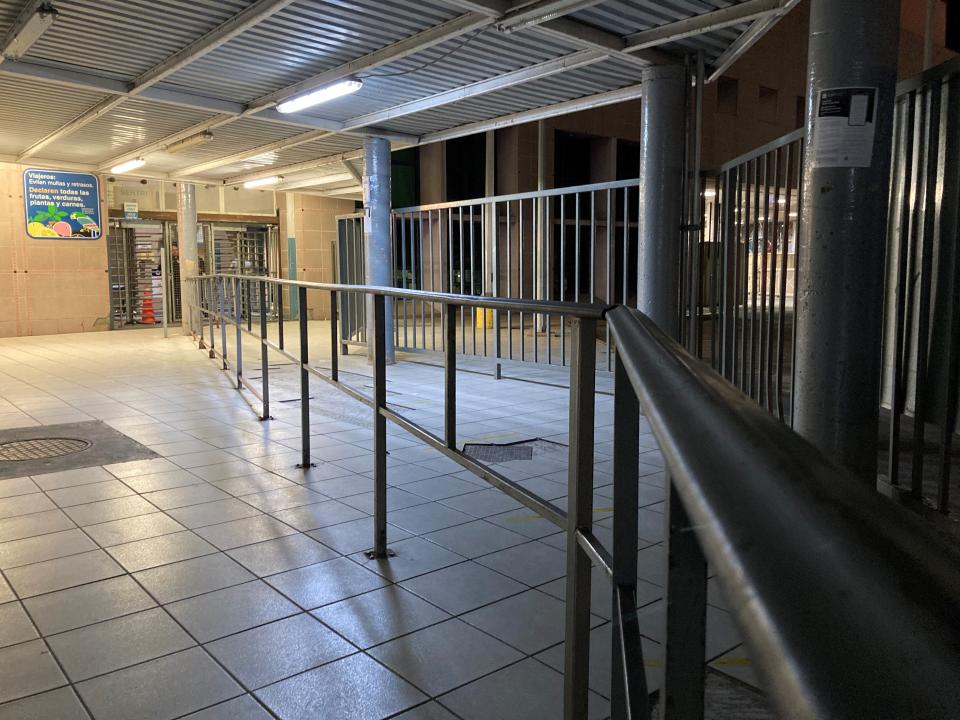
NOGALES, Sonora — No one stood in line at the passenger crossing at the Dennis DeConcini Port of Entry when Title 42 was finally lifted at 9 p.m. after more than three years.
“It feels a bit anticlimactic,” said Chelsea Sachau, managing attorney of the Border Action Team at the Florence Immigrant and Refugee Rights Project.
Migrants may be waiting to see what happens in the hours and days after the end of the restriction before showing up at the port of entry, Sachau said.
People may have been discouraged to approach the port of entry because of the Biden administration’s finalized rule that would restrict their access to asylum.
Flyers announcing the new expanded functions of CBP One were taped along the fences of the passenger crossing.
— José Ignacio Castañeda
Sinema again blasts Biden over Title 42
U.S. Sen. Kyrsten Sinema blasted the Biden administration just before Title 42 expired on Thursday, reiterating her longtime complaint about the government being unprepared for its effects along the border.
“The Administration’s insufficient preparation for the end of Title 42 is unacceptable, and Arizona border communities bear the cost,” Sinema, I-Ariz., said in a statement.
“As Title 42 ends, I’ll continue pushing for additional assistance to Arizona communities in need, and I will keep working with (Sen. Tom Tillis, R-N.C.) and other bipartisan partners to help secure our border, keep Arizonans safe, and ensure migrants are treated fairly and humanely.”
The statement ratchets up concerns Sinema has voiced since Biden has sought to end the pandemic-era health rule that has helped limit immigration.
— Ronald J. Hansen
Judge blocks ‘paroling’ of migrants
WASHINGTON − A federal judge in Florida on Thursday blocked a Biden administration plan to release migrants in the U.S. on "parole" because of a surge expected once the emergency immigration restriction known as Title 42 lifts.U.S. District Judge T. Kent Wetherell in the Northern District of Florida wrote that a Biden administration memorandum outlining the parole policy appeared to conflict with a decision from the court in a separate case earlier this year.
Wetherell, nominated by then-President Donald Trump, said his order would take effect at 11:59 p.m. Eastern Time.
"The Southwest Border has been out of control for the past 2 years," Wetherell wrote. "And it is about to get worse because, at midnight tonight, the Title 42 order expires."
— USA TODAY

Mexican police fan out along border
TIJUANA — As the expiration of Title 42 neared on Thursday night, Mexican police and military fanned out along the U.S.-Mexico border fence in Tijuana.
Members of Mexico’s Federal Police, the Mexican Army and the National Guard could be seen on Thursday evening setting up patrol points every few hundred yards in the areas of Tijuana west of the San Ysidro border crossing with San Diego. The National Guard could also be seen moving across Tijuana on Thursday evening.
Mexico’s President Andres Manuel Lopez Obrador had pledged to deploy the military in the lead-up to Title 42, especially along Mexico’s southern border with Guatemala to stem the flow of migrants crossing through Mexico.
While most of the attention along the border has been focused in Ciudad Juarez, in the past migrants have attempted to rush the border fence in Tijuana leading U.S. officials to deploy tear gas on at least two occasions.
Some of the areas where Mexican soldiers set up guard include the portion where a makeshift camp of asylum seekers had propped up on the American side of the fence, two miles west of the San Ysidro crossing.
— Rafael Carranza
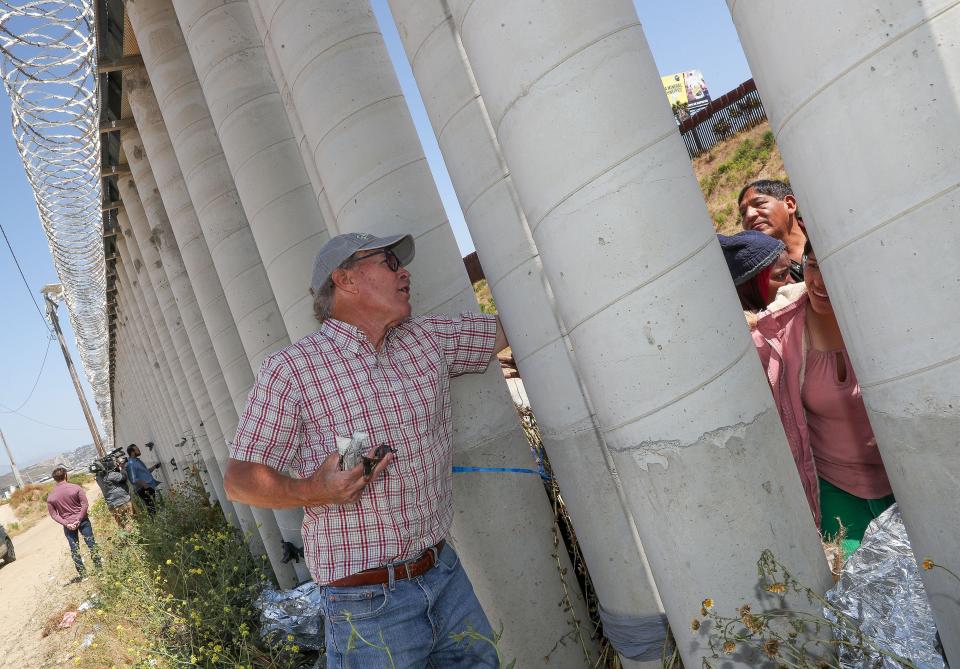
Business as usual in Nogales, Arizona, as leaders prepare
NOGALES — Despite the uncertainty ahead regarding Title 42, things on the American side of the border in Nogales were largely operating like normal on Thursday.
Children continued to play excitedly in the schoolyards just a stone’s throw away from one of the busiest border crossings in the state while cars and pedestrians made their way through town.
People shopped, ate and crossed into Mexico and back with relative ease, thanks at least in part to a shorter-than-average wait time throughout most of the day.
If it weren't for the occasional marked Border Patrol car passing by, someone strolling through the city this afternoon could be completely oblivious to the looming expiration of the pandemic-era restrictions.
While Nogales Mayor Jorge Maldonado has been working closely with law enforcement and the leaders in Mexico, he doesn’t expect anything too far out of the norm when Title 42 eventually ends.
When he wakes up on Friday and looks at the entry, he said he expects to see the “same tranquility” that usually characterizes the daily flow of travel through the port.
Nogales, along with other border towns in the state, have been told to expect migrants somewhere in the “low hundreds,” Maldonado said.
But instead of the mad rush of people that many might be picturing, he said the limited processing ability in the city will likely mean long wait times, even for those who have scheduled appointments through the agency app.
While the city has three ports of entry, the DeConcini port is the only processing center available to manage all of the migrants.
“There’s no reason to have 200 to 300 people in line if they’re not going to be able to process them,” he said. “Stay at the shelters, eat, sleep, whatever, until your time comes.”
He also warned that those who decide to walk in instead of making an appointment will be handled last.
Another reason Maldonado isn’t particularly worried is because Nogales is usually resistant to many of the problems faced by other busy border towns because it lacks certain resources.
“We don’t have a federal courthouse. We don’t have all that here for all their needs,” he said. “None of these people are looking to stay here.”
Instead, the city serves primarily as just one of many stopovers on a migrant’s journey, he said. Most who arrive here are gone within 48 hours.
And while he’s not specifically concerned about a rush of people, he did join other border town leaders in requesting an emergency declaration for the area, largely as a precaution to protect locals.
“If you don’t do it and you spend funds, you won’t get refunded,” he said. “There’s no reason why we should spend taxpayers' money, the community’s money on situations that are being forced onto us.”
— Lacey Latch
Yuma organization reaches maximum capacity
SOMERTON — The only organization helping migrants released by U.S. Border Patrol in Yuma County reached their maximum capacity just hours before Title 42 is slated to be lifted.
The Regional Center for Border Health helped 798 asylum seekers released into Yuma on Thursday move on to their destinations.
Once Title 42 ends at 9 p.m. Thursday night, local officials expect the numbers of people crossing the border to increase dramatically.
“We are going to reach our capacity and there is nothing we can do,” said Amanda Aguirre, the president and CEO of the Regional Center and former Arizona state senator.
Their capacity to process migrants and help them purchase bus and plane tickets out of Yuma is between 700 and 800 people.
At Yuma City Hall, Mayor Douglas Nicholls announced Thursday that Border Patrol plans to release 141 migrants into various areas of the county on Friday. Those who will be released are people who have been vetted and allowed to go through the judicial process to seek asylum, a process that could take years.
Those 141 street releases are on top of the 800 migrants Aguirre expects to pass through the regional center Friday.
At the news conference, Nicholls also demanded President Biden declare a national state of emergency at the border. He said Yuma County has seen an increase in the last month from 300 to 1,000 people crossing every day.
“We don’t want street releases, but the numbers that are crossing the border is going to be so overwhelming. We are already overwhelmed,” Aguirre said.
For those 141 people Aguirre said the center will try to process them in another location with help from the Yuma Fire Department.
The Regional Center for Border Health is also working to send some of the additional asylum seekers to Phoenix, while they put others in a hotel as they wait for more buses.
Typically, the Regional Center for Border Health sends buses to pick up the migrants directly from the detention centers.
Aguirre explained because of Yuma’s lack of transportation access — a bus stop with just one bench and just a few buses a day, and an airport with limited flights — street releases add challenges for asylum seekers trying to get to their sponsors.
Aguirre said typically sponsors buy the tickets for them and the center will help with additional funds if they need more money for the tickets.
— Sarah Lapidus
Migrants wait to be processed
SAN LUIS — About 100 people huddled under white canopies Thursday afternoon, waiting in lines to be processed by U.S. Border Patrol.
Most were men of different ages. All had been standing in the Yuma County heat for hours. By 3 p.m., it was 86 degrees, and some of them had been waiting for several days.
The migrants were on the other side of Trump’s 30-foot wall, drinking from water bottles left by volunteers with the AZ-CA Humanitarian Coalition. The smell of sweat mixed with the hot, dusty air.
In groups of about 30 people, border patrol agents took migrants’ passports, and photos of their faces before having them load buses to take them to the processing centers.
Farmland and bumpy dirt roads sprawled out opposite the migrants into Yuma.
Migrants described how they had stayed under these tents the previous night in frigid temperatures. The cold forced them to find wood for fires to keep themselves and the children warm. Some people had been there for as many as four days and others had just arrived. Earlier that morning migrants said there had been about 300 more people including women and children.
Some men were dressed in button-up shirts with jeans, others in T-shirts and others in sweaters. Most had backpacks. Everyone was lacking shoe laces, as requested by border patrol agents.
After hours and days of standing huddled under the white canopies, many audibly sounded disappointed when border patrol told them they were changing shifts and it would be three more hours.
“Sit down, but stay in your spot,” a border patrol agent suggested to them.
— Sarah Lapidus
US House passes Secure Border Act
With Title 42 expiring Thursday, the U.S. House of Representatives passed The Secure Border Act of 2023, the Republican immigration and border bill. The legislation would, among other things, compel U.S. Customs and Border Patrol to have at least 22,000 agents and resume construction of the border wall.
Arizona’s congressional delegation voted along party lines, with all Republicans (Reps. David Schweikert; Eli Crane; Andy Biggs; Juan Ciscomani; Debbie Lesko and Paul Gosar) voting for it. Only two GOP members in the entire House voted against the legislation: Reps. John Duarte, R-Calif., and Thomas Massie, R-Ky.
“My home state of Arizona is getting pummeled by the flood of invading illegals,” Gosar said in a statement. “I have visited the border countless times. I have witnessed firsthand the destruction caused by this lawlessness. … With this vote, Republicans have done what Joe Biden refuses to do: secure the border, stop the lawlessness and make America safe. I am proud to have cast my vote in favor of the Secure the Border Act.”
Biggs said the legislation "better secures our southern border, turns off the incentives for illegal immigration, reestablishes order and integrity in our immigration system, and provides Border Patrol Agents the resources and legal tools necessary to regain control of the border.”
All Democrats from Arizona (Reps. Ruben Gallego, Greg Stanton, and Raúl Grijalva) voted against it.
“There is no universe in which this bill is a serious solution to reforming our immigration system,” Gallego said in a statement. “Comprehensive reform means addressing the humanitarian crisis, cracking down on traffickers, and reforming the asylum process so that legitimate applicants are not waiting years in limbo.”
Grijalva blamed "the broken immigration system that Congress has failed to fix."
The Secure Border Act of 2023 is unlikely to pass in the Senate and faces a veto threat from President Joe Biden.
— Tara Kavaler
Port of entry across border in Nogales fortified
NOGALES, Sonora — Shipping container barriers topped with concertina wire and metal poles blocked three vehicle lanes into the U.S. at the Dennis DeConcini Port of Entry on Thursday afternoon. Two of the green and beige containers flanked the vehicle lane for cars coming into Mexico.
Graffiti sprayed onto one of the containers read “bad junk” underneath bold black letters that read “property of U.S. Army.” Spools of the concertina wire were stacked from floor to ceiling at one of the openings of the port.
“CBP has taken several steps to maintain the security of our facilities in the event of large crowds to include slowing or halting the flow of traffic, the implementation of port hardening infrastructure and the deployment of officers to ensure the safety and integrity of the port of entry,” John Mennell, U.S. Customs and Border Protection's public affairs specialist for Arizona, said in a written statement.
The concertina wire has been at the port since May 3 when a photo of the wire was posted to Facebook by someone waiting to drive through.
There also appeared to be an increased presence of Mexican military personnel near the traffic roundabout steps from the port of entry. The overall scene of the port of entry otherwise was calm with normal operations going on.
— Jose Ignacio Castaneda
Vineyard Community Church receives nearly 50 migrants
Nearly 50 migrants arrived at the shelter at Vineyard Community Church in Gilbert on Thursday morning, most of them having journeyed for weeks from Peru, Colombia, Ecuador and Dominican Republic.
Most of them said they arrived after fleeing unsafe circumstances, extortion, threats, financial and political instability and a lack of job opportunities. Many said they had been waiting to enter the United States for about two weeks, and a few said they had been waiting for nearly a month.
At the shelter, they received water, food, coffee, clothing, and a bag of toiletries.
Magdalena Schwartz, the director of the shelter and pastor at the church, said the number was about the same she has seen in past weeks.
The shelter opened its doors to receive migrants in October 2018 and since then has been receiving them weekly on Thursdays and Fridays, Schwartz said.
"Here we receive them, we help them continue the entire asylum procedure, we give them all the instructions, and we give them food, we give them coffee, we give them what we can," Schwartz said.
Schwartz said she fears the shelter might not be prepared for the end of Title 42, and she urged the state government to provide local organizations with more funding to better assist people who come in seeking help.
She also asked for the help of the community with donations, particularly clothing.
"We have very little clothing because the funds aren't enough," Schwartz said. "Many of these people arrive with clothes from three or two months ago that have not been changed, and they really appreciate that they can wear new clothes and feel clean."
— Laura Daniella Sepúlveda
Title 42 timing not significant for families at Mesa church
Asylum seekers dropped off at the Iglesia Cristina Buen Pastor Church in Mesa ate a spaghetti lunch served by volunteers, took showers and changed into fresh clothes provided by the shelter Thursday.Héctor Ramírez, the pastor, and volunteers began driving some families to the airport or to local hotels to spend the night since the church has stopped providing overnight shelter.
None of the families who spoke to The Arizona Republic said they had timed their trip to the U.S. because Title 42 was ending. They said they were fleeing domestic violence, threats from organized criminals and severe poverty in their communities in Ecuador, Bolivia, Peru and Colombia.
— Daniel Gonzalez
Small border communities seek federal emergency
Joining the chorus of Arizona politicians and institutions asking for a federal emergency declaration to address the end of Title 42 are several small communities in the state.
The cities of Douglas, Nogales, San Luis and Somerton, as well as the Yuma County supervisors, all are calling for a federal emergency declaration.
“A federal emergency declaration needs to be considered immediately to address the challenges that come with the end of Title 42 provisions,” San Luis Mayor Nieves Riedel said in a news release.
“The sheer number of migrants can easily overwhelm the capacities of the Border Health Center operations of providing temporary shelter and basic medical services. We fear those released or entering our city will not have the transportation options necessary to get to major cities with broader shelter capabilities – like Yuma or Tucson.”
Statements from the other communities echoed similar concerns.
San Luis has a population of about 36,000.
“Our dedicated men and women in our Police Department and Fire Department face tremendous strain,” Nieves continued. “Most importantly, we cannot leave our residents without their services in emergency situations.
— Staff reports
Normal day at Phoenix bus station ahead of Title 42 end
Luis Enrique Chavarría and José Palacios are two Nicaraguan immigrants who met Thursday at the Greyhound terminal in Phoenix while waiting for the bus that would take them to their destinations — one to Colorado and the other to California.
In addition to being from the same country, the two have other things in common: They turned themselves in at the U.S.-Mexico border, applied for asylum and received a work permit from the authorities while their immigration cases are processed.
At midday Thursday, the Greyhound terminal located at Buckeye and 21st streets, operated with the normal activity of any given weekday, with about 30 people waiting for the bus.
Both Chavarría and Palacios were released into the U.S. just last month. They are making their way to other states where their loved ones live.
Both are in favor of the U.S. granting asylum to migrants fleeing their countries, but have mixed opinions regarding the end of Title 42.
“It is very difficult, one risks their life to undertake this journey that sometimes ends badly,” Chavarría said. “I think ending Title 42 would be like motivating people to come, to hit the road without imagining what awaits them.”
Chavarría, 21, who was a professional soccer player in Nicaragua, said that in Mexico he had to travel in a truck with about 300 others. “We couldn't breathe, 12 women fainted, we were lucky to finish the trip, but there are many who don't make it,” he said.
Palacios, 35, who worked picking crops in Nicaragua, said he has family and friends who dream of making their way to the U.S. in search of a better life.
“There is no other option. In Nicaragua, you do not have the support of the government, there is no work, a lot of crime. I had to leave my wife and my daughters to seek a better life,” Palacios said. “I understand migrants because I am one of them, and I am in favor of receiving them in the United States, granting them permits because all we want is to work and have a better life.”
— Javier Arce
Migrants warned of scammers
NOGALES — Pedro De Velasco, director of education and advocacy at the Kino Border Initiative, warned migrants against scammers near Nogales ports of entry seeking to take advantage of the change in U.S. policy.
Kino Border Initiative officials have previously received reports from migrants who had received calls from people claiming to be with U.S. Customs and Border Protection or with the consulate’s office asking them to confirm their CBP One appointment.
De Velasco urged migrants during a town hall at the migrant shelter not to believe the false calls as they attempt to request asylum through the government app.
— José Ignacio Castañeda
Migrants cheer the end of Title 42
NOGALES, Mexico — The news of Title 42’s sunset was met with a round of applause from about 200 migrants who had gathered at the Kino Border Initiative migrant shelter in Nogales, Sonora, on Thursday morning.
Shelter officials led a town hall to inform migrants about the end of the border restriction on Thursday night while also advising them about President Joe Biden’s new rule that would heavily restrict their access to asylum.
The finalized rule would require migrants to request and be denied asylum in a country that they passed along their way to the U.S.-Mexico border.
Some migrants had previously asked shelter officials if they could show up to the Dennis DeConcini Port of Entry when Title 42 expires at 8:59 p.m. in Arizona.
— José Ignacio Castañeda
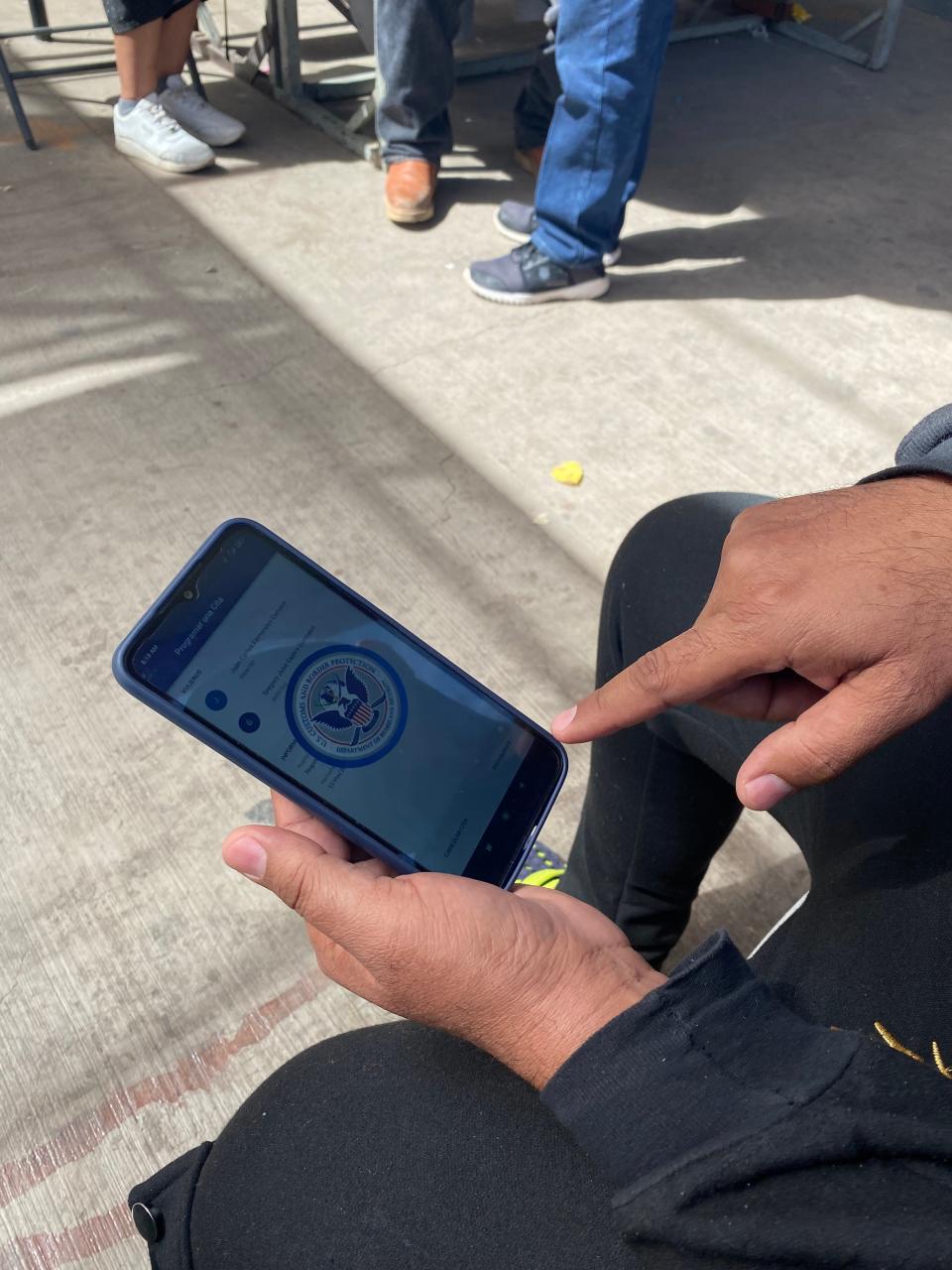
Makeshift camp rises near U.S.-Mexico border near San Diego
TIJUANA, Mexico — A makeshift camp with migrants waiting to be processed by U.S. Border Patrol popped up approximately 2 miles west of the San Ysidro Port of Entry in San Diego.
The camp is located on the border enforcement zone on the American side, in between the two border barriers separating San Diego from Tijuana.
The number of migrants camped out was unclear, but Tijuana officials estimated there were 500 people.
Makeshift tents using tarps or metallic mylar blankets lined the secondary border fence.
Another large group sat on the dirt floor waiting a few feet south of the fence for further instructions.
On Thursday morning, more than a dozen marked and unmarked Border Patrol vehicles were at the camp, along with numerous agents. CBP helicopters also flew overhead repeatedly.
Border Patrol vans stopped at the camp to pick up smaller groups of migrants. But it was unclear what would happen to the larger group.
With hours to go until the end of Title 42, the scene in San Diego resembled the situation in El Paso as migrants waited to be processed.
— Rafael Carranza
Arizona congressional delegation calls for action
Arizona's congressional delegation took to Twitter to express their opinions on the end of Title 42.
Rep. Gosar, R-Ariz., tweeted that the border would be inundated with migrants when Title 42 ends. He wrote: "Border states must repel the invaders as is their right."
Reps. Andy Biggs, R-Ariz., and Debbie Lesko, R-Ariz., expressed support for The Secure Border Act of 2023, the Republican immigration and border bill set to pass the House on Thursday.
Rep. Greg Stanton tweeted a letter he took the lead on writing with the New Democrat Coalition to Speaker Kevin McCarthy, R-Calif., and minority leader Rep. Hakeem Jeffries, D-N.Y., expressing opposition to the GOP bill and calling for a bipartisan solution to immigration. Stanton is the chair of the coalition's Immigration and Border Security Task Force.
Sens. Kyrsten Sinema, I-Ariz., and Mark Kelly, D-Ariz., both expressed that Arizona would bear the brunt of Title 42 ending, and that they have and would continue to put pressure on the Biden administration to provide additional assistance to Arizona.
Rep. Ruben Gallego, D-Ariz., was at the border Tuesday and spoke with Politico.
“Look, we’re about to come up onto a very serious time in two days. I think at this point, we should really put on the table an emergency declaration,” Gallego said, according to a transcript provided by his staff. “I think that will actually do a lot of help for that area. I think that talking to the mayors and the nonprofits in the area, that’s something that I think could actually be more helpful kind of help deal with the situation we’re seeing on the ground.”
— Tara Kavaler
Mesa church welcomes usual number of asylum seekers
A Department of Homeland Security bus pulled into the parking lot of Iglesia Cristiana Buen Pastor — the Good Shepherd Christian Church — in Mesa at 8:19 a.m.
A total of 32 asylum seekers stepped off the bus, all of them families with children. Hector Ramirez, the pastor, stood in the parking lot welcoming the asylum seekers in Spanish.
“Bienvenidos,” Ramirez said.
The asylum seekers came from Argentina, Peru, Ecuador, Bolivia, Paraguay, Colombia, Brazil and Angola.
The number of asylum seekers and the countries they came from is what the church typically receives every Thursday. He expects the number of asylum seekers dropped off at the church could triple by next Thursday.
Title 42 expulsions have mostly applied to asylum seekers from Mexico, Guatemala, El Salvador, Honduras, Cuba and Venezuela.
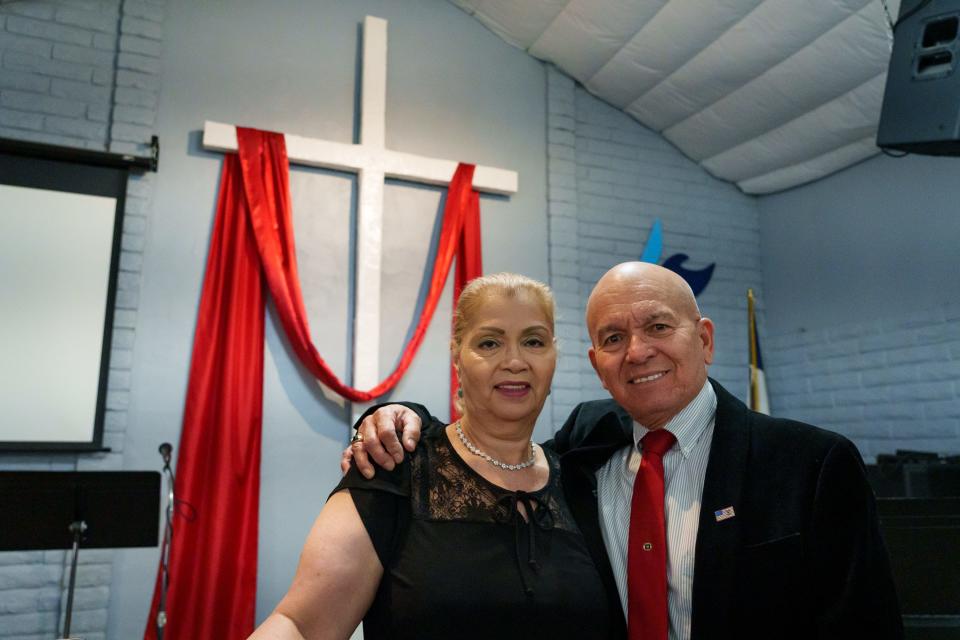
As a result, Ramirez said he expects to see more asylum seekers from those countries dropped off at the church once Title 42 ends.
Most of the asylum seekers only remain at the church for a few hours or overnight until they or relatives in the U.S. can purchase plane tickets to travel to their final destinations, usually in other states.
After arriving at the church, Ramirez explained why they were there.
“You are in the United States,” Ramirez said inside the church sanctuary, as the travel-weary asylum seekers sat in chairs, many of them with small children and babies. “You are not prisoners. You are free.”
The asylum seekers were given hot coffee, juice and sandwiches for breakfast. They sat at long white plastic tables, texting relatives with updates.
Ramirez also huddled the asylum seekers in the front of the church to pray. He warned that they would face many challenges in the U.S. applying for asylum, and he asked God to protect them. Some parents wept.
— Daniel Gonzalez
More: How Phoenix humanitarian groups are preparing for end of Title 42
Nogales urges federal emergency declaration
NOGALES — Nogales city officials urged the Biden administration to consider declaring a federal emergency as the community struggles to manage the increase in migrant arrivals in Title 42’s waning hours.
The declaration would cut through the red tape and give the federal government the ability to supply the city with the resources, personnel and infrastructure it needs, according to a written statement from Nogales Mayor Jorge Maldonado.
“I’m incredibly proud of the work we’ve done and will continue to do to mitigate the impact of this migrant surge, but with what we have now, I know it isn’t enough,” the statement said.
“That’s why I firmly believe the option of a federal emergency declaration should be explored.”
— José Ignacio Castañeda
Arizona medical centers prepare to get busy
DOUGLAS — As migrant street releases begin in southern Arizona prior to the lifting of Title 42, medical providers were also preparing for a surge in migrants.
“There is strong coordination and communication locally,” Chiricahua Community Health Centers said in a statement.
The health care provider runs clinics in Douglas and throughout Cochise County.
“We are all trying to figure out what may happen and be as prepared as we can given the circumstances at hand,” said Jonathan Melk, the CEO of Chiricahua Community Health Centers in an interview with KOLK News 13.
He reiterated that while there are not enough health care providers to care for the local community, they will do what they can for the influx of migrants, but they would need help.
“If there was something more that was needed, a larger effort, or a more sustained effort, then we would need help with that,” he said.
Additional effort could include using their mobile clinics, which will cost $5,000 per day to operate.
According to a statement released by Chiricahua, Douglas will be used as a “transit point” where asylum seekers will be offered transportation to migrant shelter Casa Alitas in Tucson, run by the Catholic Community Services of Arizona.
“Our current understanding is that they are planning to release about 200 individuals per day and have already started a beta test of the process whereby they cluster street releases and direct people through immigration and let them know that a bus will be at the Walmart parking lot to take them to Tucson,” Chiricahua said in the statement.
While migrants are not obligated to take the bus, according to the health care provider, almost everyone has accepted the offer of transportation.
Douglas Mayor Donald Huish said that while there are no long lines of migrants crossing the border into Agua Prieta, the Mexican city adjacent to Douglas, there are about 6,000 people in Hermosillo, who were expected to either head toward Nogales or Agua Prieta in the next few days.
— Sarah Lapidus
What is Title 42? What is Title 8? Here's what to know about US border policies
Yuma will seek federal money to address increased migrant flow
YUMA — Yuma announced it is working with federal, state and regional partners to prepare for the anticipated surge of migrants after Title 42 is lifted Thursday night and replaced once again by the immigration enforcement process under Title 8.
According to the city, Yuma County sees more than 1,000 migrants crossing the border every day. This high number of people crossing the border led Mayor Douglas Nicholls to issue an emergency proclamation.
Those who entered the U.S. into Yuma were transported out of the county by the U.S. Department of Homeland Security and the Regional Center for Border Health.
However, after Title 42 ends, the Border Patrol Yuma sector is expected to become even busier and reach capacity. If capacity is reached, the city said it is prepared to work with federal, state and local government entities, as well as humanitarian organizations to “address the humanitarian crisis.”
“The City does not have funding for the transportation, feeding and sheltering of migrants and in the event has to provide any services, would request reimbursement from the appropriate state and federal agencies,” Yuma said in a news release.
The city responded to locals who were concerned the city might use the Yuma Readiness and Community Center as a transition area for migrant releases, noting the site was assessed for this purpose, but “it is no longer an option.”
— Sarah Lapidus
Migrants line up at the border to turn themselves in
YUMA — Early Thursday, more than 100 people lined up to turn themselves into Border Patrol at a gap in the wall at the U.S.-Mexico border.
People stood solemnly in line with looks of exhaustion etched on their faces.
People of all ages were present: parents with infants and toddlers, several elderly people, a few older teenagers, and many middle age and young adults. Some were dressed in winter jackets and hats, others wore jeans and sweatshirts. Others were underdressed for the brisk morning, wearing just shorts and slip-on sandals.
“Embarazada,” or pregnant, one woman called out to the Spanish-speaking agent. He brought her to the front of the line.
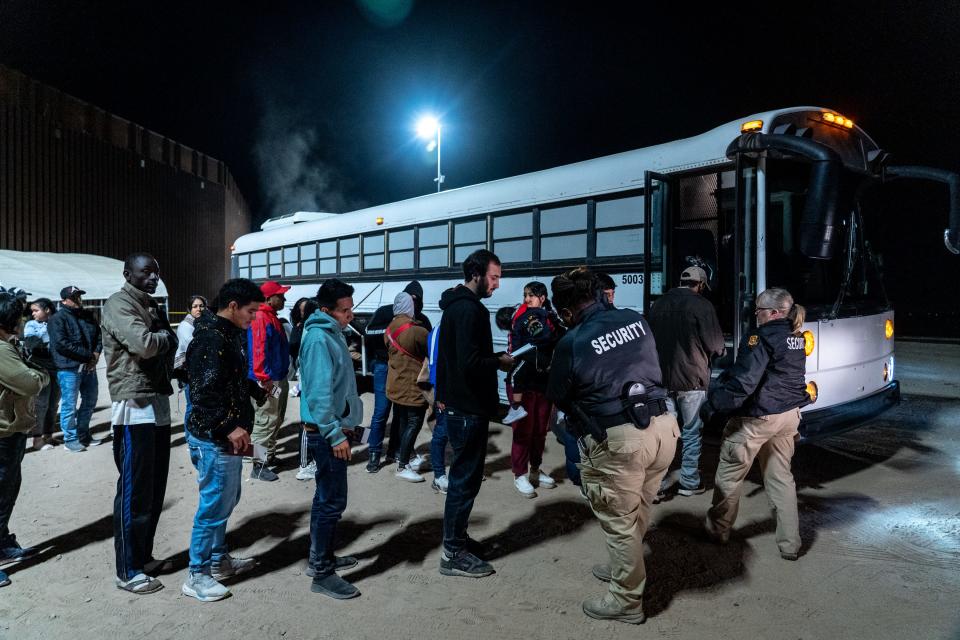
Border Patrol agents took groups of people to a lit area along the wall. They had them take their shoelaces off, put their documents in small plastic bags and took photos of them. Then they loaded them up in white buses to take them to the processing facility, frisking them before letting them on the bus.
By 3 a.m., five buses had come and taken 40 people each. There were at least 20 countries represented that night with a variety of languages spoken, including Spanish, Chinese, French and Nepalese, among others. After the buses left, more people trickled across the vehicle barrier, waiting for their turn in line.
— Sarah Lapidus
As Title 42 ends, migrants dream of entering US
NOGALES, Sonora — Many people waiting in border communities in Mexico fled their home countries because of poverty, gang violence, political violence and climate change.
The Kino Border Initiative provides services to hundreds of people a day and can house up to 85 people who are allowed to stay up to 10 days in its shelter. The nonprofit serves food and connects people with services, from social work to medical assistance, legal assistance and therapy. Many come to use the shelter's Wi-Fi to apply on the CBP One application for appointments to enter the U.S. and plead their asylum cases.
Brayan Martinez, 24, from Colombia, escaped after being forcibly recruited by armed groups in Bogotá.
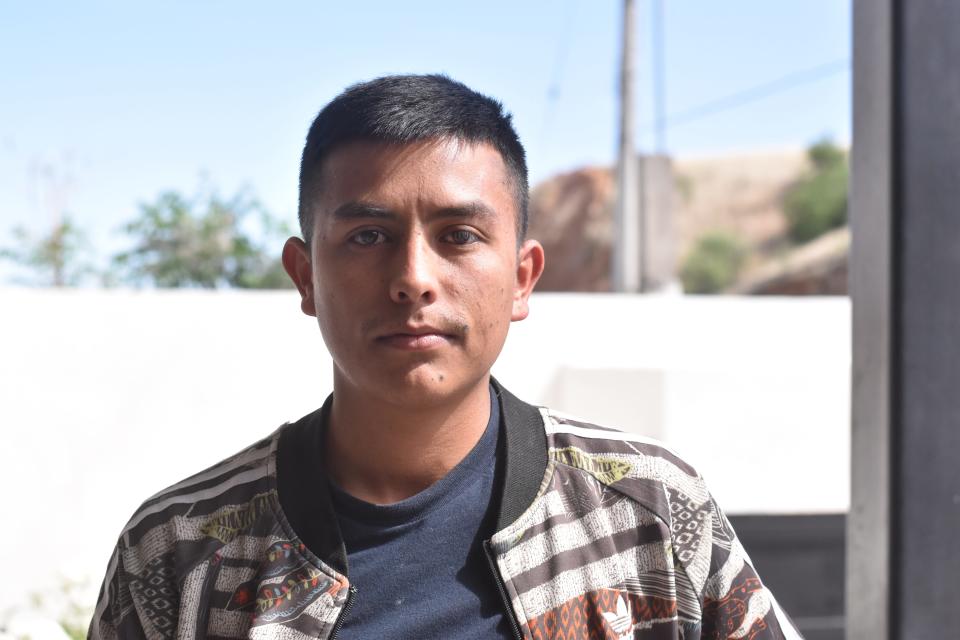
“I was scared, so I came here. They threatened me. They killed two of my uncles,” he said in an interview last week. They violated him, he said, and he was terrified they would kill him. One day he found an opportunity and escaped.
Martinez said he had been trying to get an appointment on the CBP One application, but it kept glitching and just showed him error message after error message.
He said he hopes someone can help him.
“I don’t want to return. I’m scared of going back,” Martinez said.
— Sarah Lapidus
Border Patrol is as prepared as it can be for border restriction's end, Tucson chief says
TUCSON — The chief patrol agent of Tucson’s Border Patrol Sector said Monday that the agency was “incredibly well prepared” for the end of a pandemic-era border restriction days before it was expected to expire.
John Modlin, chief patrol agent of the U.S. Border Patrol's Tucson Sector, detailed how the agency was preparing Monday at an event at Davis-Monthan Air Force Base. While Modlin underscored the Border Patrol’s readiness for the end of Title 42, he described its sunset as “concerning” and said capacity was strained at Arizona Border Patrol holding facilities.
“It's hard to understand what's coming at us,” Modlin said. “I think we're as prepared as we can be for it.”
U.S. officials are estimating migrant encounters at the U.S.-Mexico border to increase to 10,000 per day when the restriction lifts.
There have been 146,301 migrant encounters by Border Patrol in the Tucson sector so far in fiscal year 2023, which began in October, according to CBP data. Encounters increased by about 19% from the same time last year, per CBP data.
— José Ignacio Castañeda Perez
Government app for asylum seekers, CBP One, doesn’t work very well
Migrants who want to seek asylum in the United States must use the government’s new CBP One app to schedule appointments with border officials after Title 42 lifts at 8:59 p.m. Thursday.
However, the app has received negative reviews since it was rolled out by the Biden administration.
Read more about the legal, technical and practical concerns that critics have raised about the app in this report.
— José Ignacio Castañeda Perez
Maricopa County Supervisor asks Biden for emergency resources
Maricopa County Supervisor Thomas Galvin on Wednesday wrote to President Biden asking for additional emergency resources to help the region address the expected increase in people crossing the border.
“Unfortunately, for Arizona generally, and Maricopa County specifically, the federal government is needlessly creating a humanitarian issue with very real consequences for the economy and security on our communities which are still reeling from the social impact of the pandemic,” Galvin wrote.
“Not having properly communicated plans from the federal government, ahead of an anticipated surge in migration, will make an already dire situation demonstrably worse. This is problematic, at the very least on a good-governance level, and, at worst, it is a humanitarian crisis in the making.”
He said county communities deserve to be safe and secure “and migrants should be treated fairly and humanely,” and that county residents deserve “nothing less” than additional emergency resources to ensure that happens.
— Ryan Randazzo

Arizona sheriffs meet with Gov. Hobbs over safety concerns
Ten county sheriffs met with Gov. Katie Hobbs on Tuesday to discuss their concerns that the end of Title 42 could create safety concerns across the state if large numbers of people attempt to cross the border.
One concern was that human and drug-smuggling cartels could take advantage of a chaotic situation, according to the Arizona Sheriff’s Association.
“For decades, the federal government has failed Arizona with its unsuccessful attempts at border security,” Arizona Sheriffs Association president and Yavapai Sheriff David Rhodes said. “Sheriffs and other law enforcement from across the state seize as much fentanyl here than the rest of the country combined. We need the resources to combat drug and human smuggling. Our message to Gov. Hobbs was plain and simple: help is needed.”
— The Arizona Republic staff
The Arizona Republic answers your questions about the end of Title 42
Wondering about the turmoil surrounding the end of Title 42, which expires at 8:59 p.m. Thursday?
U.S. border officials have used the public health policy, which was enacted during the COVID-19 pandemic, to quickly expel migrants nearly 3 million times.
Since its implementation, asylum seekers hoping to gain entry into the United States have been stymied. The Biden administration was bracing for a surge based on that pent-up demand at the border.
José Ignacio Castañeda Perez, The Republic's border reporter, gives you a crash course on Title 42 with this explainer: "What is Title 42 and is it ending? The US border immigration policy, explained."
— Dan Nowicki
This article originally appeared on Arizona Republic: Latest updates on Title 42 end: Migrants waiting to cross border

